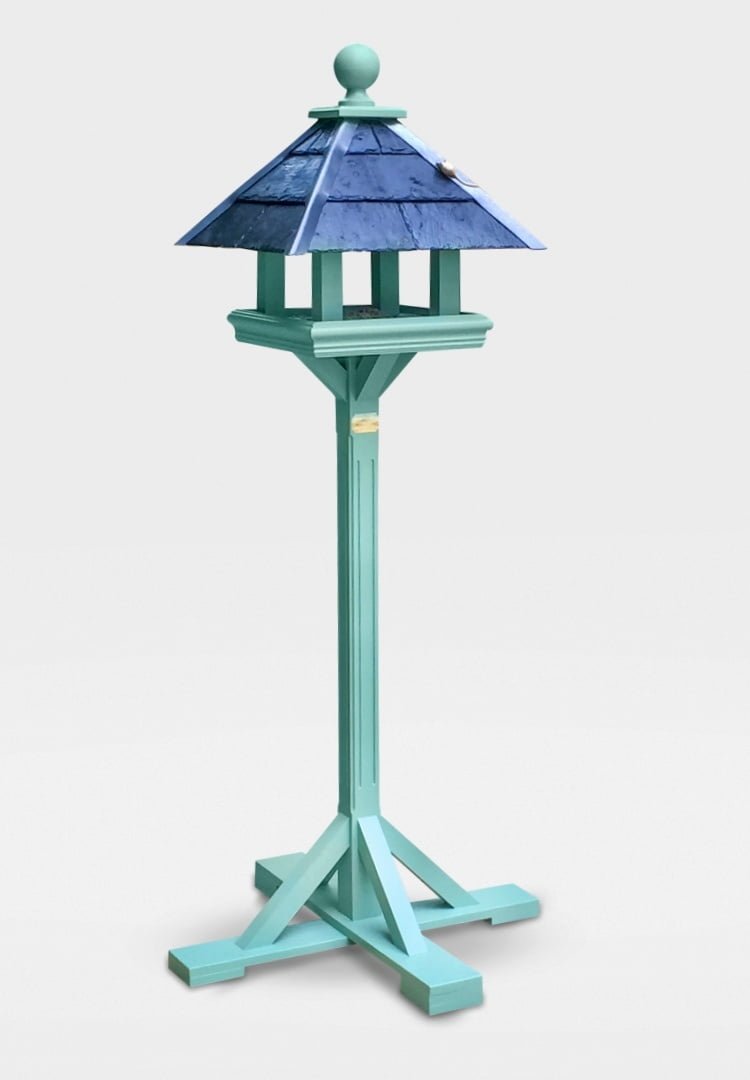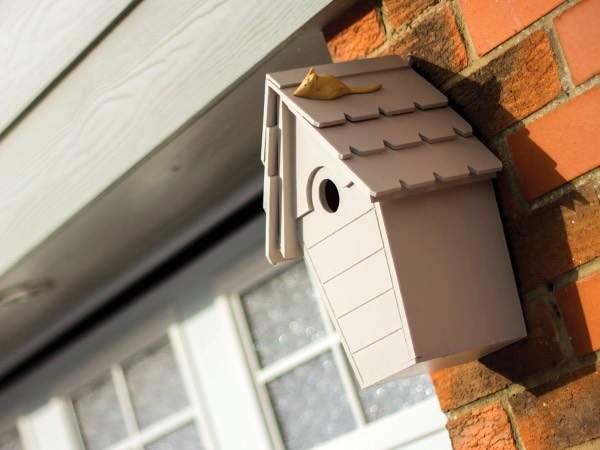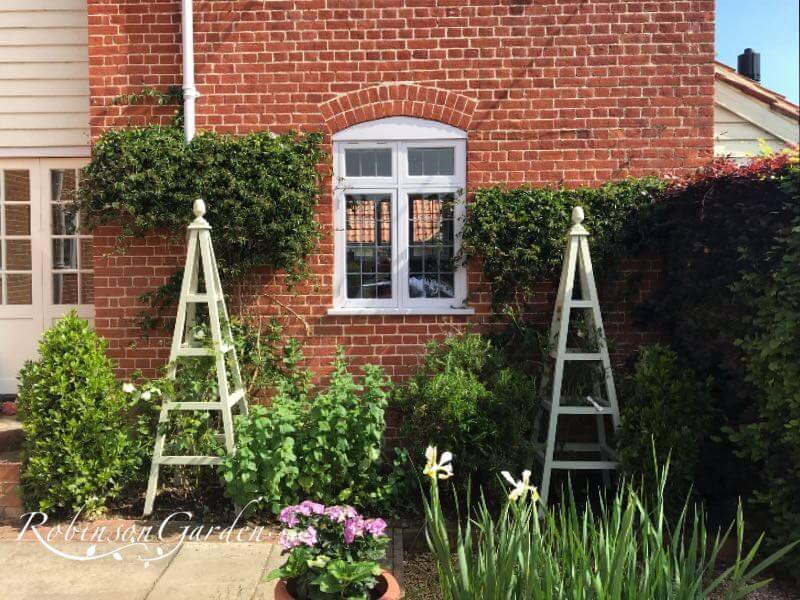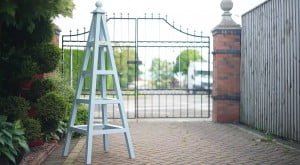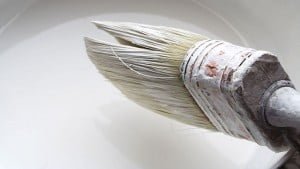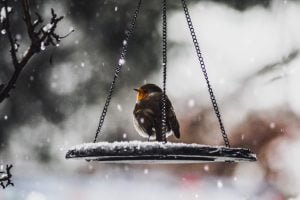Congratulations on the purchase of your bespoke garden product. Are you looking for a product care guide? If so, you are in the right place. As with all our outdoor products, simply buying a product and not regularly maintaining it will often lead to quick deterioration, which often leads to irreversible damage.
So, to keep on top of general maintenance, we have created an easy-to-reference guide on how to keep your garden products looking their best all year around.

Maintaining Slate Roofs on Dovecotes, Dog Kennels and Bird Tables
Why do you use Reclaimed Welsh Slate?
All our reclaimed Slate is originally sourced from Wales. Wales has a Globally recognised reputation for one of the highest quality graded Slate, and we couldn’t agree more!
How do I maintain the reclaimed Welsh slate roof?
To ensure that the Slate stays in top condition, we would recommend that you apply slate/teak oil onto the Slate at least once a year to lock in its quality and shine.
Applying the slate/teak Oil allows the Slate to breathe while actively repelling water and dirt, enhancing its natural beauty. Slate/teak oil can be purchased from all good hardware stores, garden centres or DIY shops.
How do I apply Slate / Teak oil onto the Slate roof?
Pour a small amount of the oil into a small tub using a dry paintbrush on a dry day. Lightly coat the roof with oil, with a similar technique to painting.
If you have applied too much to an area, use an old cloth to work the oil into the Slate to give an even coat. Use a ladder if required, always taking care as the Slate may be slippery and sharp.
What other maintenance may be required for slate roofs?
It is essential to ensure that water is running off the roof onto the floor. If the water is collecting underneath the slate tiles, this could allow for water to sit under the roof, causing irreversible damage.
To stop this, fill any gaps you see with a clear setting exterior and use silicone to prevent the water from getting in between the roof and the tiles.

Maintaining Paint on Dovecotes, Dove houses, Bird Tables, Bird feeding platforms, Bird Boxes, Nesting Boxes and Wooden Obelisks using Farrow and Ball / Little Greene Paint
What paint do you use?
All the paint that we use is from Farrow & Ball and the Little Greene Company. We apply at least three coats on top of a specially formulated undercoat.
Steps to maintain the paint on your bespoke garden products
We highly recommend cleaning your product with lukewarm soapy water as an annual job. Once dried, apply Farrow & Ball / Little Greene paint and allow to dry. When purchasing paint, ensure that you buy an exterior eggshell finish with the correct protection for outdoor use.
- Ensure you use genuine Farrow & Ball / Little Greene exterior eggshell paint
- If the paint has peeled to the wood, rub down with soft sandpaper
- Wipe off the dust with a dry cloth and apply Farrow & Ball / Little Greene exterior undercoat
- Once dried, apply Farrow & Ball / Little Greene exterior eggshell paint
Please note
Robinson Garden cannot be held responsible for the ongoing maintenance of your garden products. If ongoing maintenance isn’t done, this may heavily impact the lifespan and aesthetics of your outdoor items.
Useful Websites
Farrow & Ball Exterior Undercoat Guide – Click Here
Farrow & Ball Exterior Eggshell Paint Colours – Click Here
Preparing surfaces and applying paint on exterior woodwork – Click Here
Farrow & Ball Exterior Eggshell Paint Details – Click Here
Farrow & Ball Exterior Eggshell Product Advice Sheet – Click Here
Little Greene PDF Advice Sheet – Click Here
Little Greene – Using Exterior Paint Colours – Click Here
Little Greene – How to paint Garden Furniture – Click Here
Cleaning your Bespoke Garden products
Give your bespoke garden product a good wash as regularly as possible to get rid of lichens, leaves, soil, and bird droppings. This is especially beneficial if your products have been sitting beneath a tree.
When cleaning, use a cloth with lukewarm soapy water, lightly wipe the garden product, and then wipe dry. Do not use a hosepipe or jet washer, as this can damage the product.
Brush off debris every time you put out fresh food and scrub the table with a mild disinfectant solution every few weeks. Move the bird table from time to time to stop the accumulation of droppings underneath. Some bird diseases can be transmitted to people. Although the risk is small, it is always worth taking sensible hygienic precautions.
Guidance on cleaning around wild garden birds – Ensure that you clean your bird table regularly, never allowing debris, muck, or food to accumulate. Dirty bird tables / Dovecotes and Bird Boxes can harbour dangerous bacteria left by sick birds and start an outbreak of disease.
General Cleaning
Give your wooden garden furniture a good wash as regularly as possible to get rid of lichens, leaves, soil, and bird droppings. This is especially beneficial if your item is sitting beneath a tree.
When cleaning, use a cloth with lukewarm soapy water, lightly wipe the seated arbour, and then wipe dry. Do not use a hosepipe or jet washer, as this can damage the product.
Annual Cleaning
Although it’s tempting to leave cleaning your garden furniture until you want to use it in the Spring, it is much better for the timber to do this in the Autumn. Dirt holds moisture far longer than something clean, and the moisture brings on decay.
By cleaning it, you will also be getting it in a state where it can dry out from time to time on a sunny day, even in winter. If you are putting it under cover, removing the dirt will also mean that it does not dry hard onto the furniture.
Annually cleaning your nesting box/bird box – this is best carried out after the nesting season. Clean the interior and exterior of your bird box, ensuring it is still the best place for the nesting home to be positioned. Once the nesting season has ended, using gloves, access the interior of the bird box via the back, twisting the wood door panel either left or right. Discard any previous nests made so that it is ready for the new season. It may be likely that your nesting box will need annual paint to keep its elegant nature. We advise you do this over several dry days. Sand down rough areas, and then dust down with a dry cloth. We recommend you apply at least one undercoat where your sanding has reached the wood. Please leave it to dry for roughly two/three hours, ensuring you use the correct undercoat colour. Once you have done this, you can start applying the colour of your choice, applying at least two coats with two / three hours between coats.
Steps for removing grime, mildew, leaves, and droppings from your bespoke garden products
You must keep your bespoke garden products as clean as reasonably possible. As a natural product, the exterior environment can affect longevity. Also, keeping your bird table, bird boxes, and dovecotes clean will help keep potential parasites and diseases to a minimum.
First, fill one of your buckets with water and add washing-up liquid. Fill the second bucket with clear water. Take the soft cloth and moisten it in the washing-up liquid solution. Then wring the cloth out so that it is barely moist.
Mildew is a mould that can grow and flourish in an environment where oxygen, moisture and organic material can combine to cause a reaction. If it grows upon your garden furniture, it will appear green in appearance and will ruin its aesthetic. The good news is that most mould and mildew can be removed via a few simple cleaning-based steps.
Use the barely moist cloth to scrub the areas affected by mildew. For the best results, concentrate on each problem area at a time. Once you are pleased that the problem area has been sufficiently cleaned, take another clean cloth and rinse with clean water. Then take a third clean cloth to dry the problem section.
NEVER use a power washer or hose pipe directly onto your bespoke garden products!!!
Annual care and maintenance of your Bespoke Garden products
Yearly maintenance is best carried out in Autumn. Clean your garden furniture and make sure it is still the best place for your garden furniture to be positioned. It may be likely that your garden products will need annual paint to keep them in their elegant nature. We advise you do this on a dry day.
An overview of the annual maintenance of your bespoke garden products:
- Keep your bespoke garden product clean, avoiding mess being left on your garden product for long periods. If left, it can damage the paint and cause discolour. Defining mess includes mud, bird mess, food, leaves, grass trimmings and other types of garden waste.
- Sand down any areas that are rough, and then dust down with a dry cloth.
- Once the dirt and rough areas are sanded down, the next step is re-painting. Follow the Farrow & Ball / Little Greene Paint Guide for extra details and tips. If you require an undercoat to be applied, use Farrow and Ball / Little Greene Exterior Undercoat in the correct undercoat colour, as this varies depending on your choice of main coat colour. Once you have done this, apply the topcoat of Farrow & Ball / Little Greene exterior eggshell colour of your choice, applying at least two coats with two / three hours between coats.
- For Dovecotes – ensure each separate compartment is cleared and cleaned before the next nesting season. Sand down rough areas, wipe down and re-apply undercoat followed by topcoat paint.
- Apply slate/teak oil to products with a slate roof to lock in their natural beauty. This can be purchased on Amazon or any good hardware store.
- Protect from adverse weather conditions. Always take care if you choose to move your bespoke products.
- Garden furniture with seating – Use a furniture cover to cover the seating area of your bench or seated arbour when it is not used. This will protect from water sitting on the seated area, which can cause long-term damage if not maintained. During the winter and cold or wet weather, always place a waterproof cover/tarpaulin over the seating area. Ensure that the furniture cover fully fits the seating area of the bench/arbour so the water can run off onto the floor. Use ball pegs to affix the cover onto the arbour preventing the sheet from falling off. Wrap the ball pegs around the arbour back seat slats and the front bench/arbour legs.
Where should I position my bespoke garden products?
Don’t allow wooden furniture to sit directly in a puddle or on surfaces covered in mould or is likely to be wet or waterlogged for long periods of time. It’s best to place a flat stone, pebble, Slate, or lead platform under the legs to drain and dry out from time to time. Placing on the wrong surface can have detrimental effects, which may eventually lead to rotting and deterioration.
We also highly recommend not placing your garden products directly onto natural or artificial grass or soil; it is best placed when standing on hard concrete/slabs or gravel as this allows water to run off and be easily absorbed during sunny times.
For our bespoke wooden garden obelisks, due to the weight of the obelisks, you will not need to place these into the ground or anchor them into the soil. We highly recommend that you place each obelisk leg onto a small tile or slate coaster to prevent the legs from sitting on wet soil, that way it will allow sufficient runoff and prevent short-term detrimental effects.
Where should I position my Bird Table?
It is strongly advised to place your bird table away from paths people use continually, as this will discourage the birds from using the bird table. Place the bird table where there is some tree or bush cover nearby as birds feel happier if they have an easy escape route from predators. Allow a week or so for the birds to become familiar with your bird table; you may find that the first few days’ foods will probably be left untouched.
All our bird tables have been specifically designed so that the legs have been made in proportional length to the height and weight to prevent the bird table from toppling over. However, to further avoid your bird table from falling over during adverse weather conditions, ensure that the ground is even and all four legs are stable and don’t wobble. As an extra precaution, it’s advised to purchase bird table stabilisers which peg the bird table down to the ground.
We would strongly advise not to place your bird table directly onto a surface covered in mould; this can affect the bird table’s legs causing the mould and mildew to peel off the paint and then affect the wood. To prevent this, place lead platforms underneath each of the four legs.
Where should I position my Bird Box/nesting boxes?
We have created an insightful blog article with all the answers to these questions. CLICK HERE to be directed to the blog article.

What Bird feed should I use to attract wild garden birds?
Use bird feed to attract the kind of birds you have in your area. Blue tits love black sunflower seeds. Robins love to feed on insects. Doves and Wood pigeons will eat most types of bird feed. Don’t leave seed out for more than a few days; if uneaten clean the table with a damp cloth. It’s important to avoid letting the seeds go mouldy or start to germinate.
It may be best to put a small number of seeds every day rather than a huge amount to last a long time as that may get damp and be unhealthy for the birds. This will also mean the birds become accustomed to your presence. Robins will probably even sit waiting for you when they realise your feeding routine. If you also use bird feeders, do not forget to clean those periodically also and keep the feed fresh.
Please visit our blog, which has some dedicated articles on how to attract garden birds to your garden.
Beware of Dominant Birds
Starlings, house sparrows, collared doves and the crow family may monopolise a bird table. The overhanging slate / wooden roof may deter larger species, but you are unlikely to stop them from feeding altogether. Putting out food in several places may be worthwhile, which should at least give other birds a chance.
Break up foods such as bread into smaller pieces so that large pieces cannot be snatched and carried off. Put food on the table and in a variety of feeders. Loose food should only be sufficient for a day to reduce the chance of attracting vermin at night. If pigeons increase, discourage them by containerising all food.
Our bird table roofs have been designed so that the height between the feeding platform and roof is too small for larger birds such as pigeons to fly in and take the food. To further prevent larger dominant birds from taking all the foot, purchase feeders specific for small birds.
Carrying and handling your bespoke garden products
When moving items, please take care when handling your bespoke garden product. The Slate and the Wood together can be very heavy, so please take care when moving. Very heavy items including seated arbours/benches, dovecotes and dog kennels need to be carried by at least two people.
Carrying and handling your bird table
When moving your bird table, please be aware that they are very heavy, the reason for this is due to the weight of the Slate (if you purchased one of our bird tables with a slate roof), and equally, the wooden-roofed bird tables are also heavy.
This has been done to help the bird table during adverse weather conditions as other products in the market may not be as susceptible to typical British weather as we all well know; this can be very unpredictable at times.
To further prevent your bird table from falling over during adverse weather conditions, ensure that where you position your bird table, the ground is even, and all four legs are stable and don’t wobble. As an extra precaution, it’s advised to purchase bird table stabilisers which peg the bird table down to the ground.
How to erect your Dovecote – Step-by-step Guide
If you are erecting a Ground fixed or Freestanding Dovecote, please click on the button below, which will direct you to our dedicated step-by-step guide.
Dovecote Assembly Guide – Click Here
Adverse Weather Conditions
In the winter months and, equally, the other three seasons, there may be adverse weather conditions. To prevent any damage, it may be worth sheltering your product away from somewhere that may be very windy.
Alternatively, if it isn’t already, fasten the product to the floor or put very heavy items underneath as a precaution during high winds.


